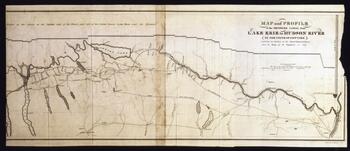Two Hundred Years on the Erie Canal

In estimating the benefits of those immense public works, that will change the internal relations of a great country, and create a new era in the history of her trade, agriculture and manufactures, much must be left for time and experience to reveal…
—New York Corresponding Association for the Promotion of Internal Improvements, 1821
The Erie Canal is one of the most famous man-made bodies of water in the world. Designed, financed, built, operated, and maintained by the people of New York, the canal was one of the largest public works projects ever attempted anywhere in the world when the first shovel of earth was turned near Rome, New York, on July 4, 1817. Men with talent and vision (but little training in engineering) charted the 363-mile course of the canal between Albany and Buffalo. They designed stone aqueducts to carry boats across rivers and locks to lift them over New York’s varied terrain. Thousands of laborers dug the ditch itself and built massive reservoirs to ensure the canal was constantly supplied with water. When it was completed in 1825, the Erie Canal connected the port of New York City on the Atlantic Ocean with the Great Lakes, dramatically transforming trade, industry, and communication in the region and across the country.
The Erie Canal was so successful that it was enlarged three times to accommodate more traffic and increasingly larger vessels. Great cities and commerce grew along the Erie Canal. Diverse people traveled east and west across its length, some spreading powerful ideas for social change. In the mid-twentieth century, canal traffic began to decline, and the famous waterway momentarily faded from public use, only to reemerge today as a vehicle for heritage tourism, recreation, and education.
Educational and Additional Resources:
Teaching with Objects Lesson--Was the Erie Canal the Information Super Highway of the 19th Century?
Bibliography of the Erie Canal/Barge Canal items in the Buffalo History Museum Research Library, including works about the Buffalo & Black Rock harbor, since they were all connected: https://www.worldcat.org/profiles/BECHS/lists/3949140?view=&count=100&se=ts&sd=asc&qt=sort_ts_asc
Ward, Dan and Ziemer, Heidi. Two Hundred Years on the Erie Canal. New York Heritage Digital Collections, September 20, 2019. https://nyheritage.org/exhibits/